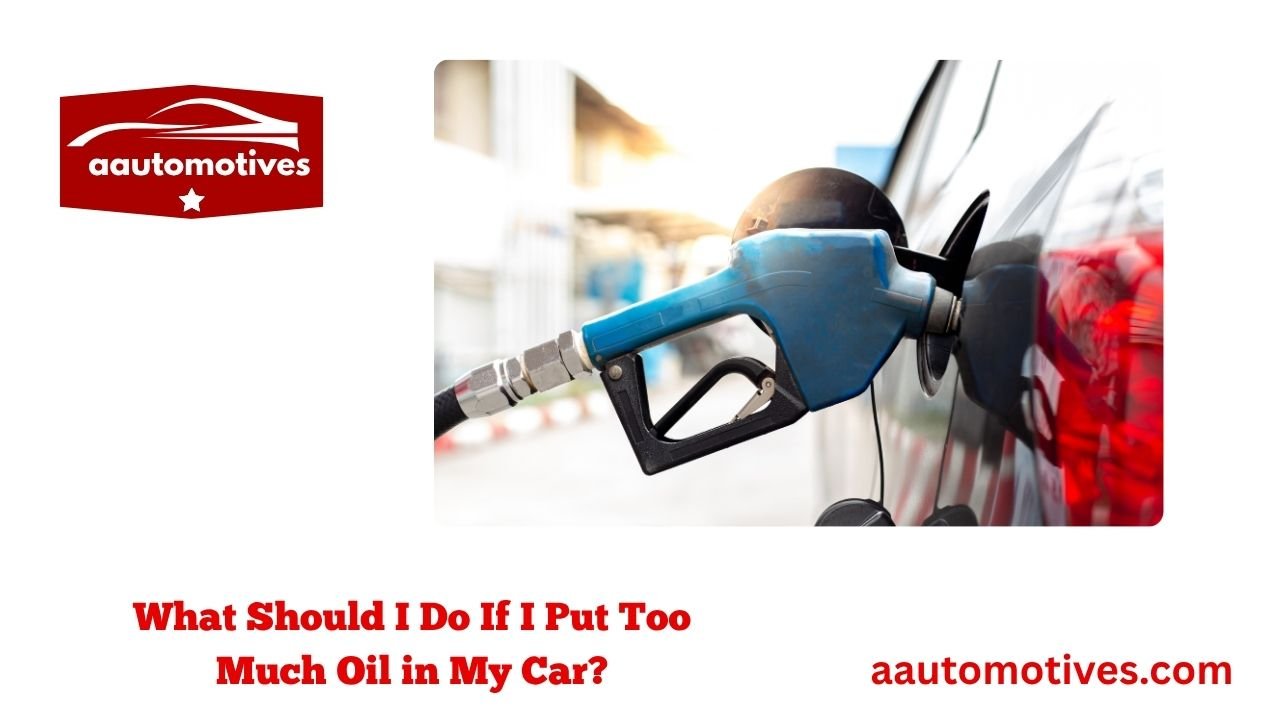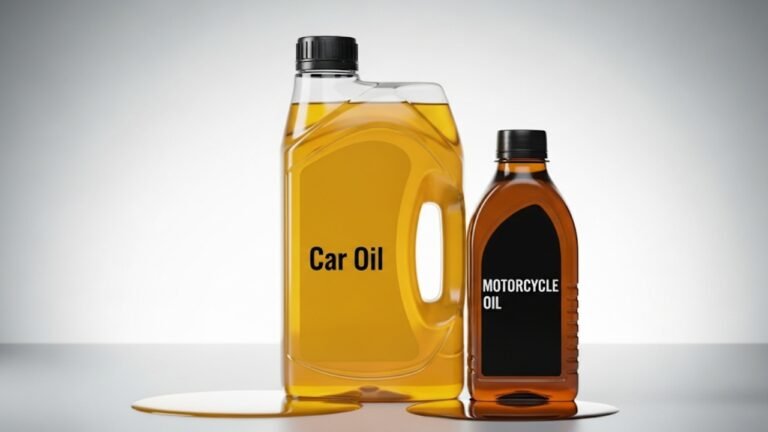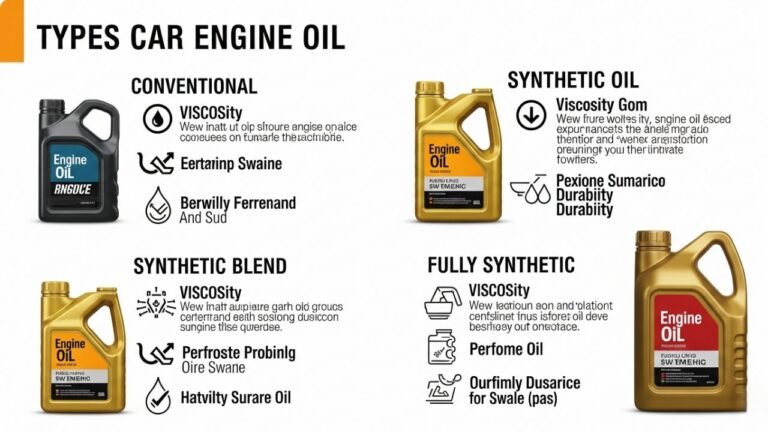What Should I Do If I Put Too Much Oil in My Car?

Let’s be real for a second—car maintenance can feel like a puzzle. And when it comes to engine oil, the stakes feel sky-high. Maybe you were in a hurry, maybe you got a little too enthusiastic trying to “top it off,” or maybe the dipstick lied (I’ve blamed it too). Whatever the case, here you are, thinking, “What should I do if I put too much oil in my car?”
First, breathe. This doesn’t mean your car is doomed. But yes, it’s something you need to handle—soon. I’ll walk you through it like I would for a friend over coffee. We’ll talk signs, consequences, how to fix it, what tools you’ll need, and a few hard-earned lessons from people (like me) who learned it the messy way.
So grab your socket wrench—or just your curiosity—and let’s fix this. One step at a time.
What Happens When There’s Too Much Oil in the Engine?
Think of your engine oil like blood in the body. It keeps things moving, lubricates, cools, and protects all the tiny parts inside your engine. But what happens when there’s too much? Imagine overfilling a soda can—it fizzes up, overflows, and makes a sticky mess. Now, imagine that inside your engine.
Here’s what actually happens when you overfill:
-
The crankshaft starts whipping the oil into foam.
-
That foam loses its ability to lubricate.
-
Parts inside the engine start rubbing without proper protection.
-
Pressure builds up and may blow seals or gaskets.
-
The engine could eventually misfire, overheat, or stall.
And worst-case? Catastrophic engine failure. But don’t worry—we’re not there yet (and you won’t be if you keep reading).
Common Signs You’ve Overfilled Your Car with Oil
Before diving under the hood, let’s get clear on what to look for. These warning signs might show up right away or sneak up after a few drives.
-
Blue or white smoke from the tailpipe (this is your engine crying).
-
Oil leaks in places there shouldn’t be any.
-
Strong oil smell inside the cabin.
-
Poor engine performance — jerky rides, stalling, or misfiring.
-
Illuminated oil light or check engine light.
-
Gurgling or frothy oil when you check the dipstick.
It’s like your car’s trying to whisper, “Hey, something’s not right.” And you’re smart to listen.
First Step: Check the Oil Level the Right Way
Before grabbing any tools or calling your mechanic cousin, let’s confirm if you’ve truly added too much oil.
How to Check Your Oil Level:
-
Park on a flat surface and let your car cool for at least 5–10 minutes.
-
Pull out the dipstick, wipe it clean, and insert it back fully.
-
Pull it out again and check where the oil mark lands.
-
If it’s significantly above the MAX line, yep—you’ve overfilled.
Pro Tip: The oil level should ideally be between the MIN and MAX lines. A little over might be okay, but too much (especially more than a quart over) is a red flag.
Why Too Much Oil Is a Big Deal (And Not Just a Little Oops)
Let’s break this down like a neighborhood story. Imagine your friend Ravi fills his engine with “just a little more” oil, thinking, “Extra protection, right?” A week later, he’s got an engine rattle louder than his auntie’s pressure cooker.
Turns out, the excess oil caused the crankshaft to aerate the oil. That oil turned into froth. And froth can’t protect metal parts. It’s like putting whipped cream in place of motor oil—useless.
Here’s what too much engine oil can damage:
| Component | What Happens | Consequence |
|---|---|---|
| Crankshaft | Whips oil into foam | Lubrication fails |
| Pistons | Struggle through thick oil | Poor performance |
| Gaskets | Pressure builds up | Oil leaks |
| Catalytic Converter | Oil gets burned | Costly replacements |
That extra oil turns helpful lubricant into a bubbling problem. You could lose power, fuel efficiency, and even the whole engine.
What Should I Do If I Put Too Much Oil in My Car?
Now, let’s get to the big question: “What should I do if I put too much oil in my car?” There’s good news—you have options. Some are DIY-friendly, others might need a mechanic’s touch.
Option 1: Drain the Excess Oil Yourself
This one’s for you if you’re comfortable getting under the car.
You’ll need:
-
Socket wrench or oil drain plug tool
-
Drain pan
-
Gloves and rags
Steps:
-
Put on gloves and place a drain pan under the oil pan.
-
Loosen the oil plug just slightly—you want to drain only a bit.
-
Watch the flow and stop once you estimate the correct amount is gone.
-
Recheck the level with the dipstick.
-
Tighten everything back up.
Aim for just below the MAX line. Don’t stress if it’s close—you can always top up later.
Option 2: Use an Oil Extractor (Easiest for Clean Hands)
No need to go under the car for this one.
What you need:
-
A manual or vacuum oil extractor
-
Rag or towel
-
Patience
Insert the extractor tube into the dipstick tube, pump or suck out the excess oil, and recheck the level. It’s like siphoning soda from a can—clean, simple, and safe.
Option 3: Call a Mechanic or Go to a Shop
If you’re unsure, or if the car’s already acting up, don’t hesitate to call in a pro. Explain the situation, and they’ll drain and refill the oil properly.
It might cost a little, but peace of mind is priceless.
How Much Is Too Much? Know Your Limits
Let’s clarify something important. Adding an extra few millimeters above the MAX line might not be dangerous. But going more than half a quart to a quart over is where problems start.
Your owner’s manual will tell you the exact capacity. Most cars hold about 4–6 quarts.
Here’s a quick oil overfill guide:
| Overfill Amount | Risk Level | Suggested Action |
|---|---|---|
| < 1/4 Quart | Low | Monitor it |
| 1/4 – 1/2 Quart | Medium | Drain a little if you can |
| > 1 Quart | High | Must drain immediately |
When in doubt, drain it out.
The Emotional Side: That “I Messed Up” Feeling
Let me pause here and just say—you’re not alone. Everyone who’s ever touched a car has made at least one mistake. Maybe you overfilled your oil. Maybe you once drove 15,000 miles without changing it (don’t look at me like that).
Cars aren’t perfect. Neither are we. What matters is that you caught it and you’re fixing it.
Mistakes don’t ruin engines—ignoring them does.
Long-Term Effects of Driving with Too Much Oil
So, you might be thinking, “I only drove a few miles—should I be worried?” The truth is, the longer you drive with excess oil, the worse the damage gets. It’s like walking with a small pebble in your shoe—it might not hurt at first, but eventually, you’re limping.
Here’s what happens over time:
-
Oil pressure skyrockets, stressing out seals and gaskets.
-
You’ll start to notice weird noises—tapping, knocking, or rough idling.
-
The spark plugs can foul, causing engine misfires or poor acceleration.
-
Worst case? The catalytic converter gets damaged from burned oil, and that’s not cheap to replace (we’re talking $900+).
Your engine isn’t just a chunk of metal—it’s a carefully balanced machine. Too much oil throws that balance off like too much salt in grandma’s biryani. Fixing it fast keeps your ride smooth and your wallet happy.
Real-Life Lessons: Drivers Who’ve Been There
Let’s talk real people, real stories.
Jasmine from Houston added “a bit extra” oil thinking it’d be safer before her road trip. On the freeway, she noticed white smoke trailing behind her. Panicked, she pulled over. Turned out the excess oil clogged her catalytic converter—a $1,200 fix. Lesson? Trust the dipstick, not your instinct.
Amit in Mumbai once poured nearly double the required oil into his Maruti thinking, “More oil means smoother engine.” Two days later, his car wouldn’t start. A local mechanic showed him the oil foaming out the breather hose. He drained it, replaced the spark plugs, and vowed never to overfill again.
See? It happens everywhere. But every one of them had the same regret—not checking twice before adding oil.
How to Avoid Overfilling Oil in the Future
Once you’ve made the mistake, you never want to repeat it. So, how do you avoid overfilling?
Use these simple tips:
-
Know your oil capacity (check the owner’s manual).
-
Always add a little at a time, then recheck with the dipstick.
-
Let the car sit 5–10 minutes after turning it off before checking.
-
Don’t rely only on oil light warnings—they can lag.
-
Use a funnel to avoid spills and overpours.
-
When in doubt, ask a pro or look it up.
Oil top-ups are like seasoning food—too little is bland, too much ruins it.
How to Safely Dispose of Excess Oil
Once you’ve drained that extra oil, don’t just toss it in the trash. Used motor oil is toxic to the environment. One gallon can pollute a million gallons of water.
Here’s how to handle it properly:
-
Store it in a sealed container (preferably the original oil bottle).
-
Label it “Used Motor Oil.”
-
Take it to a local recycling center, auto shop, or oil change facility.
-
Some petrol stations and garages accept small amounts from DIYers.
Please don’t pour it down the drain, into the soil, or the garbage. If you wouldn’t drink it, don’t dump it there.
Final Oil Maintenance Checklist (Keep This Handy)
Before we wrap up, here’s a simple checklist you can refer to anytime you’re changing or topping up your oil:
- Park on level ground
- Let the engine cool for 5–10 minutes
- Pull and wipe the dipstick
- Reinsert, pull out again, and check level
- Add small amounts if needed
- Recheck after each pour
- Never exceed the MAX mark
- Dispose of extra oil responsibly
- Mark your calendar for the next change
Consistency is key when it comes to engine care. Just like brushing your teeth—do it regularly, do it right, and you’ll avoid bigger problems later.
FAQs About Putting Too Much Oil in a Car
Let’s hit some common questions drivers ask when they find themselves in this oily mess.
Q1: Is it okay to drive with too much oil just for a short distance?
A: Maybe, but it’s risky. Even a few miles can cause foam to form, leading to engine damage. If possible, avoid driving and fix the issue right away.
Q2: How much is too much oil in a car engine?
A: If the oil level is more than ¼ to ½ quart over the max line, that’s too much. Anything over a quart? Drain it immediately.
Q3: Can too much oil ruin an engine?
A: Yes. Overfilled oil can create foam, increase pressure, blow seals, and lead to complete engine failure over time.
Q4: Can I remove extra oil myself without draining all of it?
A: Absolutely. Use an oil extractor through the dipstick tube or loosen the drain plug slightly to remove small amounts.
Q5: How do I know if my car has internal damage from too much oil?
A: Signs include white smoke, burnt oil smell, rough idling, and check engine lights. If symptoms persist after correcting the level, get it inspected.
Q6: How long does it take for too much oil to damage the engine?
A: Damage can begin within minutes of driving if foam forms or pressure builds up. Catch it early to avoid long-term issues.
Q7: Should I change the oil completely after overfilling?
A: If you’ve driven the car and the oil foamed or got dirty, it’s best to drain and refill with fresh oil.
Q8: Can my oil light come on from too much oil?
A: Sometimes. Overpressure can trigger the oil pressure warning light, so don’t ignore it—even if you just added oil.
Final Thoughts: Don’t Panic, Just Act
Look, adding too much oil to your car isn’t the end of the world. Mistakes happen. What matters is that you noticed and now you’re fixing it. You’re learning, improving, and getting more in tune with your car’s needs.
So the next time you ask yourself, “What should I do if I put too much oil in my car?” — you’ll have the answer.
- Stay calm
- Check the level
- Drain the excess
- Keep learning
Your car doesn’t need you to be perfect—it just needs you to pay attention.






